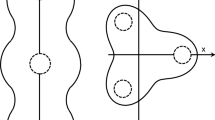Abstract
Recent experiments of Grimeset al. [Phys. Rev. B 41, 6366 (1990)] and Parshinet al. [JETP,74, 68 (1992)] demonstrate a substatial broadening in the 1s-1p transition of a single electron trapped in a liquid helium bubble (“bubblonium”) compared to theoretical predictions based on natural radiative linewidth. We show that the larger observed linewidth can be explained by inhomogeneus broadening due to quantum quadrupole fluctuations in the bubble shape. A simple adiabaticity rule for the bubblonium transitions similar to the Franck-Condon principle for molecular transitions is established. Quantitative estimates of the additional inhomogeneous linewidth atT=0 and 2.2 K are provided. The full theoretical linewidth, due to inhomogeneous and homogeneous broadening, has a Voigt-profile shape, and accounts for the data reasonably well.
Similar content being viewed by others
References
J. P. Hernandez,Rev. Mod. Phys. 63, 675 (1991).
First experiments with positrons: D. A. L. Paul and R. L. Graham,Phys. Rev. 106, 16 (1957); J. Wackerle and R. Stump,ibid. p. 18.
First experiments with electrons: L. Meyer and F. Reif,Phys. Rev. 110, 279 (1958); G. Careriet al., Nuovo Cimento 13, 186 (1959).
Wigner crystalization on the free surface of liquid helium was discovered in: C. C. Grimes, G. Adams,Phys. Rev. Lett. 42, 795 (1979); A nice photographed of the crystalline mesh is reproduced in: V. B. Shikin and P. Leiderer,Sov. Phys. JETP 54, 92 (1981).
Wigner crystallization on the interface of He3-He4 was discovered in: M. Wanner and P. Leiderer,Phys. Rev. Lett. 42, 315 (1979); also P. Leiderer,Phys. Rev. B 20, 4511 (1979).
D. Kleppner,Ann. Phys. 10(6), 877 (1985).
J. M. Doyleet al., Phys. Rev. Lett. 67, 603 (1991).
P. B. Lerner and I. M. Sokolov,JETP Lett. 44, 644 (1986).
P. B. Lerner and I. M. Sokolov,Z. Physik D 14, 173 (1989).
R. V. Jensen,Phys. Rev. A 30, 386 (1984).
E. Y. Andrei,Phys. Rev. Lett. 52, 1449 (1984).
B. E. Springett, M. H. Cohen, and J. Jortner,Phys. Rev. 159, 183 (1967).
V. S. Edelman,Sov. Phys. Usp. 23, 227 (1980).
L. D. Landau and E. M. Lifshitz,Quantum Mechanics (Pergamon, 1983) (see problems to Sec. 33); L. Schiff,Quantum Mechanics (McGraw-Hill, New York, 1968), Ch. 4.15.
C. C. Grimes and G. Adams,Phys. Rev. B 41, 6366 (1990).
A. Ya. Parshin and S. V. Pereverzev,Sov. Phys. JETP 74, 68 (1992).
I. A. Fomin,Study of Optical and Acoustic Phenomena in Quantum Liquids, Ph.D. thesis, ITF Ac. Sci USSR, Moscow (1968);ibid., JETP Lett. 6, 715 (1967).
B. DuVall and V. Celli,Phys. Rev. 180, 276 (1969).
W. B. Fowler and D. L. Dexter,Phys. Rev. 176, 337 (1968).
E. Feenberg and K. C. Hammack,Phys. Rev. 81, 285 (1951). Note that in their Eq. (3) the numerical factor should be 3/2 and not 2/3.
G. F. Bertsch and D. Tomanek,Phys. Rev. C 40, 2749 (1989).
F. R. Young,Cavitation (McGraw-Hill, New York, 1989).
V. G. Levich,Physicochemical Hydrodynamics (Prentice-Hall, Englewood Cliffs, NJ, 1962).
A. Bohr and B. R. Mottelson,Nuclear Structure (Benjamin, Menlo Park, CA, 1975), Vol. II.
For clarity we have omitted the linear term in the Hamiltonian due to the electronic energy. This term results in a non-spherical equilibrium shape for bubblonium with an electron in the 1p state. However, we are interested in line broadening effects here, and these are not affected (in first order) since the oscillator frequency is unchanged.
N. A. Jelley,Fundamentals of Nuclear Physics (Cambridge University Press, 1990), p. 41.
Cited in: H. Lamb,Hydrodynamics (Dover, New York, 1945), 6th Edition, p. 475.
This can be expected from the following argument. If bubblonium is modeled by a Three-dimensional cubic box with the same volume as the physical sphere, and the quadrupole scaling transformation as described above Eq. (13) is applied, the change in electronic energy upon deformation can be determined exactly. In this case the exact result equals our result in Eq. (15), the contribution from second-order perturbation theory being zero. For the physical system which is spherical, and not cubic, second-order perturbation may contribute, but we would expect it to be small.
J. M. Eisenberg and W. Greiner,Nuclear Theory (North-Holland, Amsterdam, 1975), p. 53.
G. K. Batchelor,Introduction to Fluid Dynamics (Cambridge University Press, 1967).
J. Poitrenaud and F. I. B. Williams,Phys. Rev. Lett. 29, 1230 (1972);32, 1213(E) (1974).
G. Herzberg,Molecular Spectra and Molecular Structure (Van Nostrand, Princeton, NJ, 1957), Chapter IV, p. 4.
The recommended values for surface tension were taken from: D. O. Edwards and W. F. Saam,Low Temperature Physics, Vol. 7A, 1978, p. 284 [Eqs. (3.9), (3.10)]. The measurements were provided in: Guoet al., Phys. Rev. Lett. 27, 1259 (1971); Zinov'era K. N., S. T. Boldarev,Sov. Phys. JETP 29, 585 (1969).
We extrapolate Parshinet al.'s data16 to zero pressure using Parshinet al.'s own extrapolation in their Fig. 11. We extrapolate Parshinet al.'s data to zero temperature “by eye”, using their Fig. 12. Similarly, we extrapolate Grimeset al.'s data (taken at 1.3 K) to a temperature of 2.2 K using the temperature dependence of Fig. 12 in Ref. 16.
J. Eberly and P. Milonni,Lasers (Pergamon, New York, 1988), Chapter 3.12.
Author information
Authors and Affiliations
Rights and permissions
About this article
Cite this article
Lerner, P.B., Chadwick, M.B. & Sokolov, I.M. Inhomogeneous broadening of electronic transitions in a liquid helium bubble: The role of shape fluctuations. J Low Temp Phys 90, 319–330 (1993). https://doi.org/10.1007/BF00682005
Received:
Revised:
Issue Date:
DOI: https://doi.org/10.1007/BF00682005




